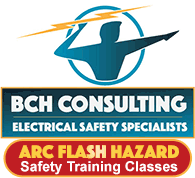If you are one of the many who is trying to decide how to provide electrical safety training for your employees, you are not alone. We are often asked how many hours of training are required per NFPA 70E. Although NFPA 70E contains guidance concerning the training of workers who are exposed to electrical hazards, there is no requirement for the length of time the training is required to take. So how do I determine which of the many electrical safety training products currently on the market is right for my organization?
Let’s start with the basics. OSHA part 1910 subpart-S Electrical is where you will find the regulations that discuss electrical safety training for employees. OSHA requires that only “qualified employees” perform electrical work. It is important to understand that a qualified worker is someone who has the technical abilities to maintain, troubleshoot and install electrical equipment properly but also has the needed safety skills and knowledge obtained through formal electrical safety training. (See 1910.332(b)(3) for training requirements that specifically apply to qualified persons.)
Qualified Employees
Most employers will choose to train their employees to the safety standards in NFPA 70E. NFPA 70E has very specific training requirements for qualified employees (see 110.2(A)(1) of the 2018 edition) if the employees you need to train fall into the qualified person demographic look for training that concentrates on these NFPA 70E requirements at a minimum. Keep in mind that technical employees typically have a kinesthetic learning style. This means that these students learn by doing (carrying out physical activities), rather than listening to a lecture or watching demonstrations. So, you may want to choose the training that offers hands-on exercises as part of the lesson plan.
NFPA 70E 110.2(A)(1) Training Requirements for a qualified person
- Precautionary techniques used for working around the hazards
- Applicable electrical policies and procedures
- Proper use of PPE, including arc flash, insulating, and shielding materials
- Proper use of insulating tools and test equipment
- Distinguish exposed, energized conductors and circuits from other parts of equipment
- Determine nominal voltage
- Understand the approach distances and determining factors for shock and arc flash boundaries
- Understand the decision-making process necessary to be able to:
- Perform job safety planning
- Identify electrical hazards
- Assess the associated risk
- Select the appropriate risk control methods, including PPE
Unqualified Employees
Keep in mind that OSHA requires that unqualified persons also need to be trained in and familiar with any electrically related safety practices which are necessary for their safety. In some cases, employees can be qualified to perform basic electrical tasks, for example, employees may be trained to operate disconnect switches as part of their lockout/tagout responsibilities or operate power tools connected to the supply via an extension cord. This could expose the employee to electrical hazards requiring the employee to receive some basic electrical safety training. Because the employee is not exposed to the same level of hazards as the qualified person, the training will not need to be as extensive ultimately requiring less time.
Safety or Management Professionals
Supervisors need trained too. OSHA 1910.332 Table S-4 specifically denotes “Blue collar supervisors” as an occupation that is required to be trained (unless their work or the work of those they supervise does not bring them or the employees they supervise close enough to exposed parts of electric circuits operating at 50 volts or more to ground for a hazard to exist).
If you need to train your safety professionals or other management officials who are responsible for the overall health and safety of the employees by instituting an organizational level electrical safety program, look for training that not only covers the qualified worker section but takes a deeper dive into some of the administrative requirements of NFPA 70E such as the electrical safety program sections, contract worker safety, training records, and annual employee field audits. Because more information will be covered this usually requires more time.
Job task analysis
Determining the length and type of electrical safety training that is right for your organization must be based on the job the employees are performing. This is what educational professionals refer to as a job task analysis. Performing this simple analysis will ultimately provide you with the foundation for your training requirements. Get an understanding of what tasks are required on the job and what knowledge, skills and abilities are necessary to be able to carry out those tasks safely. Once this has been determined, choose the training that meets those needs.
[activecampaign form=3]






